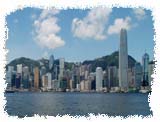HONG KONG WTO MINISTERIAL 2005: BRIEFING NOTES
TRADE AND ENVIRONMENT The “win-win” potential for trade and environment
At Doha, members agreed to launch negotiations on the liberalization of trade in environmental goods and services; on the relationship between WTO rules and trade obligations set out in multilateral environmental agreements (MEAs) and on the exchange of information between those institutions.
Contents
> Director-General’s letter to journalists
> The Doha Development Agenda
> Agriculture
> Cotton
> Services
> Market access, non-agricultural products
> Intellectual property (TRIPS)
> Trade facilitation
> Rules: ad, scm including fisheries subsidies
> Rules: regional agreements
> Dispute settlement
> Trade and environment
> Small economies
> Trade, debt and finance
> Trade and technology transfer
> Technical cooperation
> Least-developed countries
> Special and differential treatment
> Implementation issues
> Electronic commerce
> Members and accessions
> Members
> Bananas
> Statistics, Textiles and Clothing
> Statistics, Facts and Figures
> Jargon buster, Country groupings
> Jargon buster, An informal guide to ‘WTOspeak’
Liberalizing trade in environmental goods and services back to top
Ministers agreed to negotiate freer trade on environmental goods and services through the reduction or elimination of tariffs and non-tariff barriers. Examples of environmental goods and services are catalytic converters, air filters or consultancy services on wastewater management.
At the Trade and Environment Committee’s first special session, in March 2002, members agreed that the bargaining should take place in the Services Council’s negotiating “special session” and in the Negotiating Group on Market Access for Non-Agricultural Products. However, the Trade and Environment Committee’s special sessions would oversee those negotiations. And they would try to clarify the concept of what are environmental goods. In the discussion, some members have referred to the lists of environmental goods used by the Organization for Economic Cooperation and Development (OECD) and the Asia Pacific Economic Cooperation forum (APEC).
Currently, several delegations have tabled lists of what they consider environmental goods. These include products to manage pollution or products to manage natural resources. Some lists also include environmentally preferable products, which have a lesser impact on the environment in their end-use than alternative equivalents. The most ambitious lists also cover goods which are more environmentally friendly in their production, such as organic fruit or vegetables.
There are elements of convergence among these lists but there are also fundamental divergences. One of them is the issue of process and production method (PPM). A majority of members believe that goods should not be considered environmental because of the way they have been processed or produced. These members say that it is WTO inconsistent to discriminate between products based on PPM. For developing countries, the use of PPM is equated with richer countries attempting to impose their environmental and socials standards on the rest of the world.
Several members have included environmentally preferable products in their lists but most have been cautious to narrow the concept down to end-use or disposal characteristics. In general, there are divergences on how ambitious the list should be. Some members would like to work on a list of core environmental goods, while others would like to see a broader list. Alternatively, some members advocate a different approach to the list: the environmental project approach, introduced by India, would give access to environmental goods and services under a specific project for a finite period of time. The project would have to be approved by a national authority.
back to top
Identifying trade obligations
There are approximately 200 multilateral environmental agreements in place today. Only about 20 of these contain trade provisions. For example, the Montreal Protocol for the protection of the ozone layer applies restrictions on the production, consumption and export of aerosols containing chlorofluorocarbons (CFCs). The Basel Convention, which controls trade or transportation of hazardous waste across international borders, and the Convention on International Trade in Endangered Species (CITES) are other multilateral environmental agreements that contain trade provisions.
The negotiations aim to clarify the relationship between trade measures taken under the environmental agreements and WTO rules. However, in practice, so far no action taken under a MEA has been challenged in the GATT-WTO system.
Two approaches: actual obligations and broader principles
Members started the negotiations by attempting to define what a “specific trade obligation” is, and to develop a common understanding on this. Some members advocate identifying individual “specific trade obligations” that the WTO should examine. Others prefer a more general approach that would look at the principles governing the relationship between the WTO and the environmental agreements, and how the environmental agreements’ trade measures might be accommodated in the WTO. Some advocate the principle that there should be no “hierarchical” relationship between the two legal regimes with neither the WTO nor the environmental agreements being dominant.
The Trade and Environment Committee’s special sessions are following both approaches at the same time.
National experiences
By mid-2004 members were looking at the issue of national coordination in the negotiation and implementation of multilateral environmental agreements. Several delegations presented their national experience. They talked about mechanisms at home to coordinate between different governmental bodies, including between trade and environment ministries. They also presented the processes through which conflicting views were reconciled, the way stakeholders were consulted and the way MEA implementing legislation was developed.
back to top
Exchanging information
Ministers agreed in Doha to negotiate procedures to facilitate the information exchange between the secretariats of multilateral environmental agreements (MEAs) and the WTO. Currently, the Trade and Environment Committee holds information sessions once or twice a year with the different secretariats of the environmental agreements to discuss the trade-related provisions and their dispute settlement mechanisms. The Trade and Environment Committee’s special sessions have also the mandate to negotiate on criteria for the granting of observer status to MEA secretariats. The aim is to guarantee their participation and strengthen the complementarities between their work and that of the WTO.
Other material:
> Trade and
environment
> Negotiations
> Doha
declaration
> Doha declaration
explained
